This post may contain affiliate links. If you click an affiliate link and make a purchase, I may earn a commission. Also, as an Amazon Associate, I earn from qualifying purchases.--
Many riders are familiar with the wobble or shimmy that can sometimes occur on their bike wheels, and it’s usually not a good thing. As you ride along, the rear wheel will appear to wobble or shimmy back and forth, which can be pretty unsettling and alarming, especially for beginners.
If your rear wheel feels loose or wobbly while riding your bike, you could have either an issue with the spokes, your wheel could be out of true, an overheated hub, a broken axle, or there could be something in the tire itself that needs to be fixed.
Rear-wheel wobble, especially on mountain bikes and cruisers, can be a source of frustration and annoyance, but it’s almost always easily fixable (and preventable).
If you’ve experienced this problem yourself and want to know what causes this issue, then read on to find out six of the main reasons why your rear bike wheel wobbles and how to fix them!
With each revolution of our wheels, a few thin wire strands (our poor spokes!) perform an unrelentingly difficult job, being repeatedly stretched and compressed.
They also transmit the acceleration and braking forces of pedaling from the hub to the wheel rim. Those skinny little strands seem almost magical when you consider that they’re responsible for supporting the weight of a fully loaded bicycle!
Spokes are an important and sensitive component of your bike’s structure, requiring regular upgrades and care.
Misaligned spokes are a common culprit for a wobbly back wheel. The tension in your spokes should be the same on both sides of the bike to prevent any imbalances that could lead to a wobble.
If the spokes on your wheels are too loose, you’ll have to constantly fine-tune them to get them to stay tight.
If the spokes are too tight, the rim, spoke nipples, and hub flanges will be damaged.
One of the most obvious causes of wobbling during riding is a bent wheel or rim that creates shakiness and vibration which is transmitted to the front set of your bike. If your rim gets bent or damaged, it can cause the tire to make uneven contact with the road.
If you feel wobbling or vibration on the rear, then your rear wheel is subject to damage and needs immediate attention.
Damage to a wheel can be caused by hitting a pothole, bouncing into a curb, or being hit hard in an accident.
Low tire pressure is another big cause that results in shaking.
Every tire has a recommended tire pressure range that should be followed accurately if you want your bike to perform effectively.
Tires that are badly worn out and get frequently punctured can also cause low or high-speed vibrations.
A damaged or deflated tube may also cause wobbling because it reduces the amount of air pressure inside the tire. This causes your bike to ride very unstable and makes it harder to control your bike.
The rear wheel must be strong enough to carry all of your weight while leaning over and pedaling.
If you are taking your bike on rough or mountainous terrains, then you will want to make sure that this part of your bike can handle some weight and stress.
Damaged, worn-out, or deflated tires are a common cause of a rear wheel wobbleIf you’ve had any problems with your wheel wobbling or spinning out when you ride, the first thing you should do is check for bent or broken axles.
The axle is what connects your wheel to the rest of your bike and keeps it securely attached to the frame. A bent axle is caused by a harsh impact, either with another object or with something hard and rigid, such as a rock or curb.
Another sign that your axle might be damaged is if you have difficulty taking tight turns, so be very attentive when riding.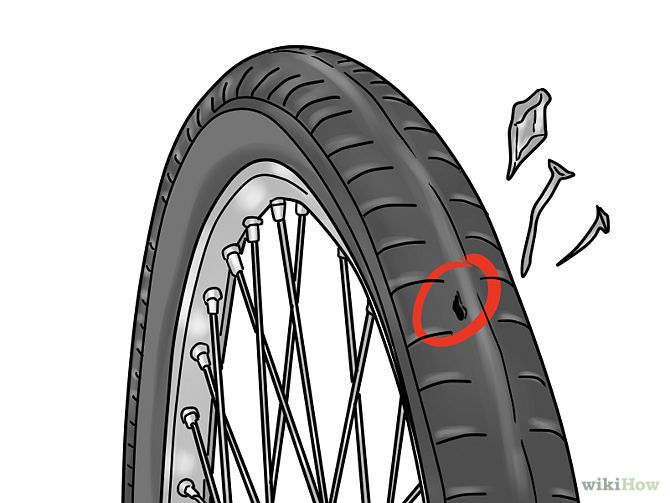
A bent or broken axle causes wobbling when pedaling because there is no balancing weight on the back of the bike’s frame. You may not realize that this is happening until you try to pedal with an unbalanced wheel and find that it wobbles back and forth every time you pedal.
When this happens, your whole body moves with every rotation of your pedals as you try to counterbalance the difference in weight between each side of the rear wheel.
This can be very uncomfortable and dangerous if you’re riding with other people on a busy road or trail at high speeds!
It may be some time before you realize that your hub is loose. The telltale signs of a loose hub include

Typically, this indicates that your wheel hub is loose.
When the hub is loose, the wheel bearings, whether they are ball or cartridge bearings, can wander from side to side. Even though this is a minor movement, the distance to the rim accentuates the wobble and creates discomfort.
The “cup and cone” hub is by far the most common form of hub used in bicycle wheels.
Although this hub is easily maintained, it requires precise adjustment to minimize friction and maximize service life.
The cones are threaded conical nuts that attach to the axle, while the cups are cast as part of the hub shell. These two pieces are separated by a steel ball bearing.
Each side of the hub has a bearing, which consists of a cup, a cone, and balls.
The bearing balls will be compressed if the cones are screwed on too tightly.
Because of this, there will be too much resistance when turning the wheel and the moving parts will wear out too quickly.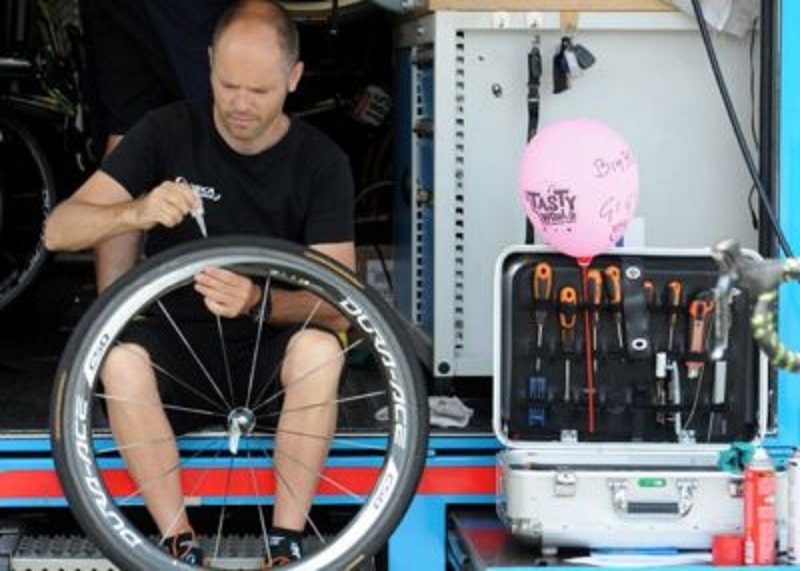
The bearings will have “play” if the cones aren’t screwed in all the way, allowing the wheel to shake freely on its axis. This causes the bike to shimmy or wobble which makes it difficult to maintain your balance.
Worn-out cup and cone bearings are a more technical issue that can be harder to assess for the un-initiatedIt can be incredibly frustrating to have a problem with your bike, especially if it has to do with your brakes, steering, or, in this case, your rear wheel wobbling.
If you find yourself dealing with rear wheel wobbling, I’ve got three potential solutions for you!
If your bike has a loose or tight spoke, it may be the biggest cause of a rear wheel wobble.
It is important to tension the spokes in the wheel in such cases to keep the tire reliable and long-lasting.
Gear required – For this task, you need a wheel truing stand, a spoke tension meter, and a spoke wrench.
Follow the given simple process step by step to ensure that your wheel is free of wobbles!
The first step is to measure the diameter of the spokes to tension them. You can use a spoke diameter gauge and find the smallest slot your spoke can fit in.
The tension meter has a conversion chart that you can use to calculate the spoke tension according to the diameter.
Lighter rims require less tension and heavy rims require more, so make sure you check with the manufacturer as the tension may vary significantly.
Now you have to hold the tension meter horizontally, squeeze the handle, place the spoke between posts and release it.
Then check the measurements on the meter’s scale. You have to cross-reference this reading with the conversion chart to find out the present tension in the spokes.
Measure every spoke on the wheel and determine whether your current spoke tension is too high or low.
Don’t be alarmed if all the spokes don’t have the same average tension, 20% difference is acceptable.
Turn the entire wheel a quarter-turn counterclockwise to adjust the tension and then repeat the measurement.
Once your spoke tension is within the acceptable range all the way around, you can true the wheel. (Source)
Rims can get damaged in several ways, including colliding with a large bump, attempting to force your bike into or out of a bike rack, or having a spoke break.
If the kink in the rim is significant enough, it will continually strike the brake pad as the wheel rotates, producing an annoying sound and slowing you down.
But don’t worry, you can easily fix this by truing the wheel yourself using only a spoke wrench, a truing stand (if you have one), and follow these 5 easy steps to get your bike back in tip-top shape!
You can begin by flipping the bike over, or placing it on a truing stand so the wheel can spin with ease.
First, check for broken spokes. If you find any, use the same method to straighten your rim, but replace the spoke as soon as possible.
Next, make sure your axle is seated in the dropouts unless you have a quick-release wheel. If the axle isn’t straight, don’t re-true the rim.
Check your brakes to make sure they weren’t damaged or the brake cable wasn’t tangled.
Carefully rotate the wheel while checking the size of the gap between the wheel and the brake pad. As the wheel rotates, you will notice that at some points the gap between them is varying, which indicates a buckled wheel.
As you slowly rotate the wheel, you will locate the part of the rim that is hitting the brake pad.
You can fix it by tightening the spokes in the direction opposite to the bend. If the rim is tugging to the left, locate the spoke on the right side of the hub that is closest to the buckle’s center.
If it is tugging to the right, locate the spoke extending from the left side of the hub.
Tightening the spokes pulls the rims away from the side it was bent to, thereby aligning it.
The nipple of the spoke needs to fit into the notch of the wrench for it to be tightened, so make sure you’re using the appropriately sized wrench.
Tighten by turning counterclockwise.
If you’re not sure, produce noise by “plucking” the spoke like a guitar string. Adjust by a full turn and try a second pluck. A higher pitch indicates a tighter spoke, while a lower pitch indicates a looser spoke.
You can tweak more spokes if you think that your wheel needs more adjustment. Rotate the wheel again to check the desired results and squeeze each pair of spokes to ensure that all gaps are even and the rim is free of dents or dings.
More than five twists of the spoke wrench mean a potentially damaged wheel. After a certain number of dents, a rim can no longer be re-trued and will need to be replaced.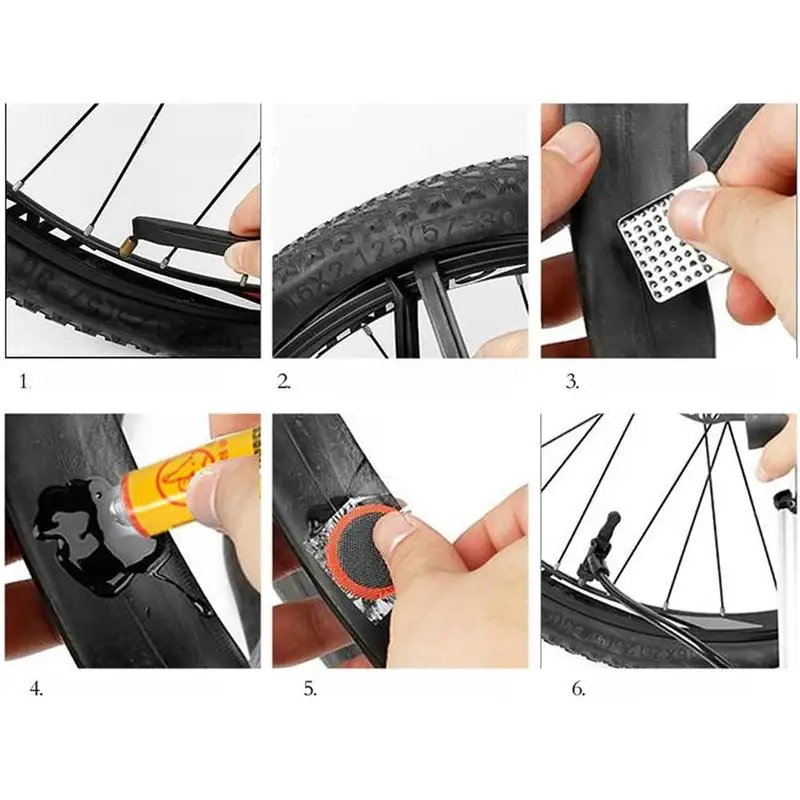 (Source)
(Source)
To inspect for a damaged hub, first keep your bike steady, hold the wheel at its highest position and shake it.
Any play, often accompanied by a clunking sound, indicates that your hub needs tightening.
For hubs that use press-fit cartridge bearings, altering the hub tension may be impossible, which means you need new bearings. All the other hubs need their bearings tightened up again.
However, overtightening the nuts and bolts can prevent the wheel from turning freely, leading to early bearing failure.
Cone nuts are commonly used to secure hubs. Find the axle, and more specifically, the pair of nuts close to where the spokes connect to the hub.
These nuts are placed side by side so the outer nut can lock the inner one into place.
To do this, you must first loosen the outer nut, then tighten the inner nut, and finally tighten the outer nut again without touching the inner nut.
Tighten the cone nuts, then rotate the wheel while holding the hub axle in place. If you don’t feel any grating or binding sensations, then the tire is free of wobble!
If you don’t feel any grating or binding sensations, then the tire is free of wobble!
Wobbling is a very common issue that plagues bikers, which often strikes at times when you have to act as quickly as possible.
While now you are aware of various problems associated with wobbling and different ways to fix them, it’s important to keep calm and not panic in such situations. If you’re a new learner, then these problems can help you identify the issues that might lead to an uncomfortable riding experience, so you can easily eliminate them and ride cautiously.
But as someone that’s experienced wheel wobble, I can assure you that once it’s happened the first time, you’ll do just about anything to stop it from happening again!
If your bicycle’s wheel is wobbly, there are several possible causes and solutions to this problem. Read on to learn how to diagnose and fix a wobbly bike wheel.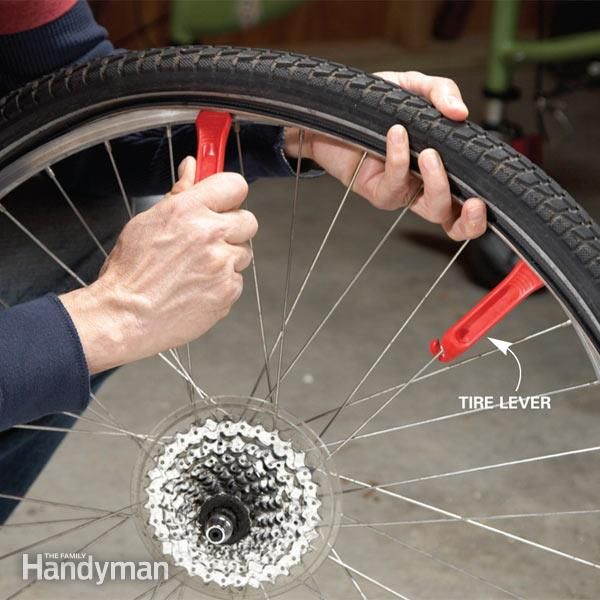 Here are some common causes and solutions. The first step in repairing a wobbly bike wheel is to check the wheel bearings. By holding the bearings in the axle position, you can check their condition. Make sure that they are tightly tightened to eliminate any play. “No play” means no sticking or binding.
Here are some common causes and solutions. The first step in repairing a wobbly bike wheel is to check the wheel bearings. By holding the bearings in the axle position, you can check their condition. Make sure that they are tightly tightened to eliminate any play. “No play” means no sticking or binding.
A wobbly bike wheel can be caused by several different causes, including loose spokes. Loose spokes are a common cause of wobbly biking and can be easily fixed by tightening them. If the wobble is frequent, a new rim may be required. A loose headset is another cause, and the frame or fork may need to be replaced. A constant speed will amplify the wobble.
A wrongly-seated tire bead can also cause wobbly wheels. If this is the case, you can deflate the tire and re-seat the bead. Rotating the wheel can help you identify any defects in your tire bead. The bead should be the same distance from the rim as the sidewalls are. If you suspect that your tire is defective, the bead may be seated in the correct location. The wobble will disappear.
The wobble will disappear.
If your bicycle wheel is wobbly, it may have a bent wheel, damaged tires, or loose spokes. In any case, it is important to check the spokes for tightness. Check the hub area, if necessary, and clean all bike parts regularly. To correct wobble, you can tighten the left side spokes. Before you ride, make sure to inspect the spokes.
Wobbly wheels can also be caused by a loose hub. If you find this, you should replace it or get a new bike wheel. This is a more expensive fix, but it’s worth the risk of an accident. Although it may be tempting to risk an injury, it is better not to cause more wobbles. Continue reading to learn how to fix wobbly bike wheels.
A wobbly bicycle wheel could be caused by worn cup-and-cone bearings. If the hub is too loose, the wheel might be out of true and slightly buckled. To test the bearings, hold the wheel in the axle position and use a permanent marker to determine whether the wobble is caused by the cones or the rim bend. This measurement should be consistent across the spokes.
This measurement should be consistent across the spokes.
A worn-out wheel bearing must be replaced. A worn-out wheel will feel rough and make a ticking noise while cycling. It is best to replace worn-out bearings. If necessary, be sure to re-grease the bearings. Two sets of bearings are found on most bikes. One set is for the front and one for the rear. Wearing bearings can cause wheels to wobble at high speeds, and brake noise.
Another common reason for wobbly bicycle wheels is a bent rear wheel. A crash or uneven terrain could cause a bent rim. In addition, the uneven spoke tension may have caused the rim to bend and make it wobbly. Misplaced tires may also cause wobbly riding and should be checked as soon as possible. These problems can be prevented from getting worse by taking care of them.
You might be wondering what to do if your bike wheel is wobbly. The answer is simple – simply flip your bike upside down and check the rim with a permanent marker. The area of contact will be the most significant lateral deviation in either direction. You should repair both the wobbles at once if you notice more than one. A permanent marker will be easier to use when you know where each spoke goes.
The area of contact will be the most significant lateral deviation in either direction. You should repair both the wobbles at once if you notice more than one. A permanent marker will be easier to use when you know where each spoke goes.
First, look for warped areas. These are areas where spokes need to be tightened. These are the areas where your wheel has more warp than usual. Start with the most warped part of the wheel, and work your way down. If you see a single warp, tighten the spokes using a truing stand.
Loose spokes can cause wobbly bikes. Tightening them is an easy way to fix a wobbly wheel. Tightening the spokes will help prevent the wobble from occurring again. In some cases, too-tight spokes may also cause the wheel to wobble. To stop the wobble, tighten the spokes one-half turn at a stretch.
Another cause of wobbling bike wheels is a loose hub. This can cause wobbling in the rear wheel. To correct wobble, tighten the cones. A locknut will hold them in place. You can also replace the hub and spokes of a wobbly bicycle wheel. Either way, it is much better to fix the problem than risk an accident.
You can also replace the hub and spokes of a wobbly bicycle wheel. Either way, it is much better to fix the problem than risk an accident.
To true a wheel, you can turn the spoke nipples to tighten or loosen them. To keep the rim round, loosen the spokes on the opposite side of the tightened one. Next, use a caliper to rotate the wheel. For a more precise truing, turn it a quarter-turn. Check for flat patches after each set of rotations.
If you have a wobbly bicycle wheel, you can either go to a bike shop or attempt to do it yourself. Bike shops usually charge between $20 and $30 to fix a wobbly bike wheel. They have the right equipment to do this. To ensure the wheel is straight, a truing stand and leg strap are required. A spoke wrench is essential for fixing a wobbly bike wheel. A spoke wrench comes in various sizes. If you can’t find one, you can use a spoke wrench on the spoke’s D-ring.
To fix a wobbly bike wheel, you need to know what’s causing it. Sometimes, a wobbly bike tire may be the cause of the wobble. Depending on where the wobble is located, you can try a simple method such as deflating the tire. Next, you can re-seat your bead and try again. If this doesn’t work, you can try another way, such as adjusting the bead to the rim.
Depending on where the wobble is located, you can try a simple method such as deflating the tire. Next, you can re-seat your bead and try again. If this doesn’t work, you can try another way, such as adjusting the bead to the rim.
Most riders have experienced riding with a wobbly bike wheel at one time or another. Worse yet, the wobble can be dangerous. Worse, the wheel can fall off, cracking and breaking the spokes. So what causes a wobbly bike wheel? Listed below are some common causes. Continue reading to find the best solution to your wobbly bicycle wheel.
Shimmying refers to excessive oscillation of the front wheel. This is commonly known as a “shimmy” and is caused by excessive lateral load on the frame and wheel. Shimmies are caused by the bike-and rider system oscillating at a high frequency. This makes it difficult for the rider’s to respond appropriately.
Another common cause of a wobbly bike wheel is loose spokes. Check the other wheels in the same area to determine if any spokes are loose. Then, tighten the spokes until you notice a twang or good enough to ride on. If your wobbly wheel keeps happening, you might need to replace it.
Check the other wheels in the same area to determine if any spokes are loose. Then, tighten the spokes until you notice a twang or good enough to ride on. If your wobbly wheel keeps happening, you might need to replace it.
There could be many reasons your wobbly bike wheels have loose spokes. A poor adjustment could cause the hub to be loose. You should first check the hub if the wheel is loose. It can result in uneven tension which can lead to wobbly wheels. Another cause of wobbling bike wheels is damaged hubs or cup-and-cone bearings.
Worse yet, the hub can also be broken. This causes the rear bike wheel to wobble. The seat stay and chainstays exert pressure on the hub, which will result in a wobbly bike wheel. To fix this problem, first, you need to check the tire pressure. If there is enough air in your tire, you can lower the pressure and rebalance it.
Untrued, buckled, or incorrectly adjusted bicycle wheel hubs can cause a wobbly bike wheel. This is the most common reason for wobbly bikes.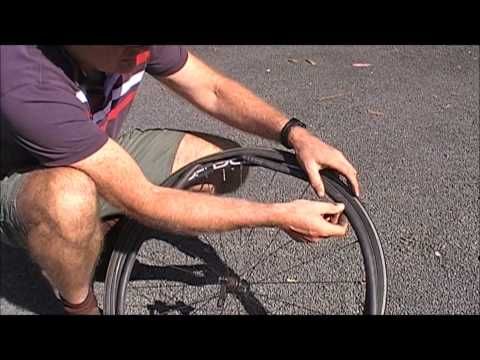 A loose head tube bolt or hub may also be a cause. Tightening the bolts should correct the wobbling problem. Other common causes of a wobbly bike wheel include loose spokes and screws, and brakes.
A loose head tube bolt or hub may also be a cause. Tightening the bolts should correct the wobbling problem. Other common causes of a wobbly bike wheel include loose spokes and screws, and brakes.
Worn-out wheels can also cause wobbly bikes. Worn rims can cause uneven forces to be applied to the spokes, leading to a damaged wheel. The cassette and chain bend the bearings of the back wheel first. This is how they usually break. If the bearings are not tight, you can tighten the left side spokes. If this fails, the rim may be too bent to adjust the spoke tension.
There are many reasons why a front wheel may become loose. Lastly, a wheel may be rubbing against something. A Road Force Balancer or tire matcher kit can be used to fix wobbly wheels. These will help you pinpoint the root cause of your wobble.
Damage like the figure eight haunts all cyclists. Owners of large wheels - 28 and 29 inches - suffer especially from this. It is advisable to learn how to fix them yourself, since it is expensive to go to the workshop every time, and it will take a lot of time. For the usual fix, if you don’t have sports calipers, but ordinary rim brakes, you can do without a balancing machine or other devices, a spoke wrench will suffice. nine0003
Owners of large wheels - 28 and 29 inches - suffer especially from this. It is advisable to learn how to fix them yourself, since it is expensive to go to the workshop every time, and it will take a lot of time. For the usual fix, if you don’t have sports calipers, but ordinary rim brakes, you can do without a balancing machine or other devices, a spoke wrench will suffice. nine0003
Depending on the nature, it is possible to conditionally divide all the curvature of the wheels into two types - the eight and the egg.
There are also several groups according to the severity:
 This occurs as a result of a long, but careful ride, when the spokes stretch over time, the mounting holes in the sleeve. Usually the runout does not exceed 3 mm.
This occurs as a result of a long, but careful ride, when the spokes stretch over time, the mounting holes in the sleeve. Usually the runout does not exceed 3 mm. In the first two cases, you will not need to make any additional purchases of material, new spokes or rims. In the latter case, you will have to buy additional spokes, discard the deformed ones, and if the rim is deformed, replace it.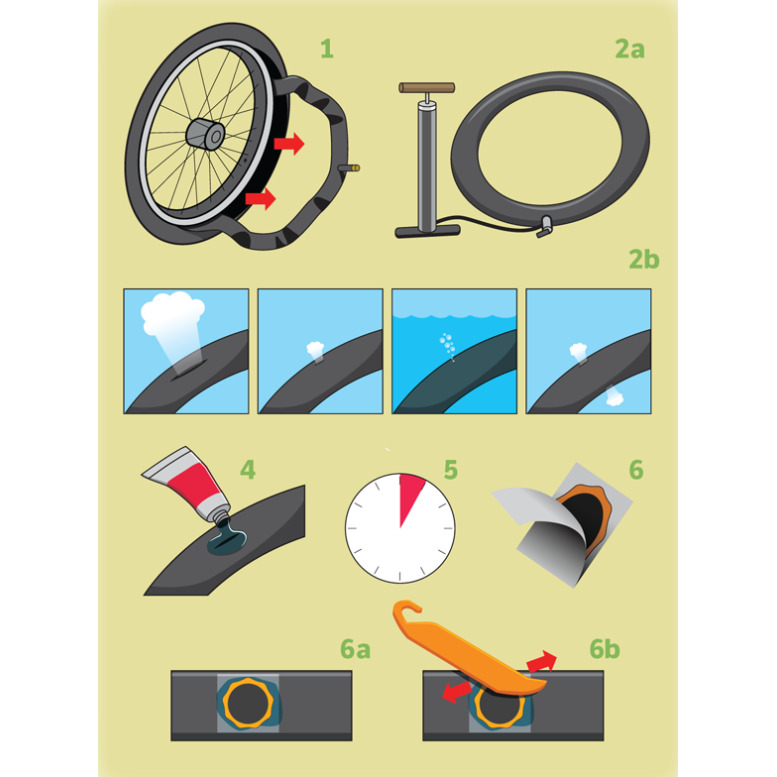 You will also have to completely re-spoke the wheel, regardless of whether all the spokes are intact or not. nine0016
You will also have to completely re-spoke the wheel, regardless of whether all the spokes are intact or not. nine0016
Not all tools and materials are required. For example, if the spokes do not need to be replaced, then you can fix the eight without them. If the rim is in order, a new one is not needed. If you do not need to remove the ratchet or star, no pullers are needed. If no replacements are needed at all, just tighten the spokes - you will need one spoke key.
This is the most important tool.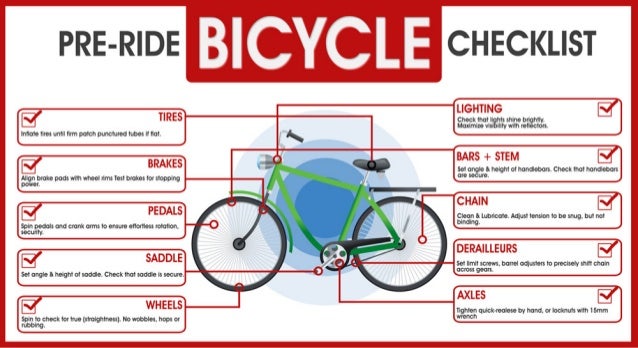 It depends on him how many eights your nipples can withstand and the comfort of work. There are two types of keys: milled, in the form of a round thing with slots for various nuts of the spoke nipples, and stamped, with one or two grooves for the nut. You need to choose milled. Let it cost more, but it will also last longer, and it is more convenient to work with it. In addition, they can knit not only the wheels of an ordinary bicycle, but also the wheels of scooters, mopeds, motorcycles, bicycles for road racing with small nipples, bicycles for extreme riding. nine0016
It depends on him how many eights your nipples can withstand and the comfort of work. There are two types of keys: milled, in the form of a round thing with slots for various nuts of the spoke nipples, and stamped, with one or two grooves for the nut. You need to choose milled. Let it cost more, but it will also last longer, and it is more convenient to work with it. In addition, they can knit not only the wheels of an ordinary bicycle, but also the wheels of scooters, mopeds, motorcycles, bicycles for road racing with small nipples, bicycles for extreme riding. nine0016
The Small Eight is a deformity that was described in item 1 of the list of severity of deformities. This also includes the “egg”, which makes it difficult to ride, but the eights cause more trouble - rim brakes will not work with them.
When correcting the axial runout of the rim (figure eight), a section of the rim is revealed where the runout exists:
 nine0016
nine0016 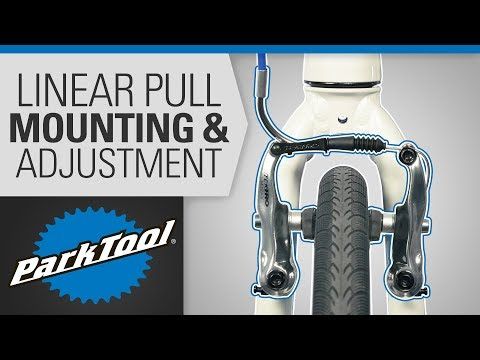 With tires with a deep "mountain" pattern, it is better to remove them - otherwise the "egg" cannot be determined. The runout is determined by deviations during the rotation of the rim. nine0016
With tires with a deep "mountain" pattern, it is better to remove them - otherwise the "egg" cannot be determined. The runout is determined by deviations during the rotation of the rim. nine0016 With cross knitting, if the spokes are intertwined through each other, it is very difficult to check the true tension, therefore it is undesirable to use such knitting. It does not give any advantages in strength, but it makes work difficult. nine0011
After tensioning the spokes, the runout is checked again, if necessary, the correction is repeated. When everything is fine, the eight is fixed.
When everything is fine, the eight is fixed.
It differs from the procedure for correcting the small eight in that all the spokes are first loosened to the point where they begin to “hang”, then they are tightened, repeating the same operations as when correcting the small eight - until not achieve the desired result.
When pulling up the spokes to the required force, do this - at the beginning they pull the spokes from the tire nipple in one direction through four, then they reach the initial one and shift by one. After that, also through four pull in the other direction. They shift in the same direction by one and then pull through four in the same direction as at the beginning, then they shift again and pull the rest in the opposite direction. This method will provide uniform tension and a minimum of corrections. If the number of spokes is different from 36, they are tightened in increments of 3, 2, 5 knitting needles or another suitable one. nine0016
nine0016
In case of damage to the rim and spokes, in case of severe curvature that makes driving difficult, the wheel must be completely disassembled. Remove the wheel, tire and tube. Loosen all the spokes and check if the rim is deformed. If it is deformed, it is replaced.
Do not attempt to fix the rim. It still won't work - you'll only crush its edges, and it will be unusable. Just buy a new one.
After that, the broken spokes are discarded, the whole ones are checked to see if they are deformed. Pay attention to the state of the bend near the hub - it should be the same on all spokes. Those that are different are replaced. nine0016
Check the condition of the hub holes. If there are holes stretched to an oval, the hub is also replaced with a new one
The spokes are lubricated along the entire length, the wheel is assembled back. Wheel assembly is the topic of a separate large article. After that, the spokes are tightened to the norm, the beating is corrected. Grease from the spokes is removed with a cloth after assembly, otherwise dirt will stick to them. Lubrication is needed so that the spokes do not “brake” against each other and on the thread, do not touch the hub holes. nine0016
Grease from the spokes is removed with a cloth after assembly, otherwise dirt will stick to them. Lubrication is needed so that the spokes do not “brake” against each other and on the thread, do not touch the hub holes. nine0016
“Egg” is an oval-shaped curvature of the wheel, in which there is no pronounced figure eight. It is corrected in the same order as the figure eight - they find the desired area, tighten the knitting needles. In the case of an egg, it is necessary to tighten the knitting needles evenly, an eighth of a turn of the key, from the edges to the middle. If the result is not achieved, the pull-up procedure is repeated.

The figure eight on a bicycle wheel is the most common deformity. Today, when creating bicycles, the latest technologies are used, but even in an ultra-modern bike, the wheel remains very conservative, spoked. The design in this case is nothing complicated: a sleeve, but a rim and spokes that unite them. During operation, every cyclist is faced with wheel deformation. And the appearance of the “eight” on the wheel is far from uncommon. This is due to the violation of the integrity of the rim and the looseness of the spokes. nine0003
During operation, every cyclist is faced with wheel deformation. And the appearance of the “eight” on the wheel is far from uncommon. This is due to the violation of the integrity of the rim and the looseness of the spokes. nine0003
And yet why does this deformation occur? During operation, the wheel is inevitably subjected to stress as soon as the cyclist takes his place on the saddle. Let's add bumps in the road - pits, bumps, poor coverage or lack thereof, and the question of the causes of the "eights" disappears by itself. In addition, inexperienced cyclists often distribute their weight on the bike incorrectly, and this also increases the load. Harsh braking, jumping and other extreme sports, as well as long-term operation also make it necessary to adjust the wheels. nine0003
As you can see, during operation, the bike experiences loads that are least dependent on your riding style. Over time, the geometry of the wheel rim changes - it is deformed. The speed of its manifestation depends on the presence of rim defects (figure eight, displacement of the "umbrella" and "egg"). It should be noted that the life of the wheels often also depends on the materials from which they are made and their quality. Sometimes inexpensive models may require repair much earlier than those made from expensive components (for example, high-strength rims). nine0016
It should be noted that the life of the wheels often also depends on the materials from which they are made and their quality. Sometimes inexpensive models may require repair much earlier than those made from expensive components (for example, high-strength rims). nine0016
How can I tell if a wheel is bent?
When there is a suspicion that the wheel has lost its original shape, you should turn the bike over and begin a thorough check.
First you need to inspect the wheel in the place of the alleged curvature. To do this, it is untwisted, while in the case of the rear, you can do this with the help of pedals. It is visually obvious that the curved sections are shifted to the side during rotation. Now it remains to grab it with your hand in that place and stop it, which is quite difficult. nine0003
Another, more effective way is to use a crayon or marker. Spinning the wheel, it must be brought to the rim. First of all, the stroke will remain on the bulge of the "eight". By spinning more and bringing the chalk closer to the rim, you can also determine the boundaries of the curvature.
By spinning more and bringing the chalk closer to the rim, you can also determine the boundaries of the curvature.
How to fix the "eight"
And here the curvature is found. Every cyclist can fix it with his own efforts, and given that deformation is not a rare phenomenon, valuable experience comes with time. There are two ways to get rid of the "ailment":
• power rectification;
• tightening and loosening of wheel spokes.
Necessary deformity repair kit:
1) chalk to mark the area with a defect;
2) spoke key;
3) wheel straightening machine (desirable, but not required).
The small figure eight can be removed without removing the wheel. To diagnose the problem, turn the bike upside down to check that the wheel is in the correct position in relation to the brake pads. This process can be divided into several operations. First you need to identify the deformation. While the wheel is spinning, press a piece of chalk against it.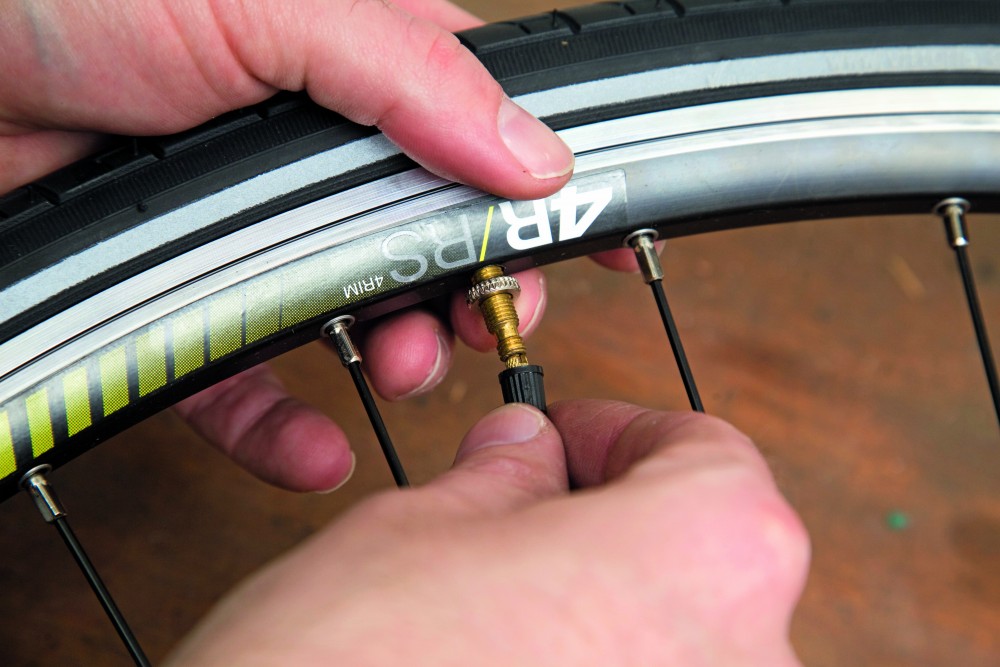 In places where the figure eight is formed, you will see a corresponding trace. This simple method will help determine the exact location of the rim deformation. nine0003
In places where the figure eight is formed, you will see a corresponding trace. This simple method will help determine the exact location of the rim deformation. nine0003
Next, the spokes will be tightened and loosened, but only from a certain side, which will be discussed in detail below. If such manipulations are performed with inaccuracies, you can give the wheel even more deformation. There are several ways in which it can be removed.
Power rectifier
Considering this scenario possible, you should remove the wheel from the frame. But the tire and the camera should not be removed. We turn the wheel with a bulge towards us and take the rim and tire with our hands. In this case, the average deformation requires the location of the hands, equal to 10 and 2 hours on the dial. We use the knee, attaching it to the convex area, and strongly push away from ourselves. nine0003
If there is enough strength, it is done in the air. And you can position the wheel vertically, with the deformed section up.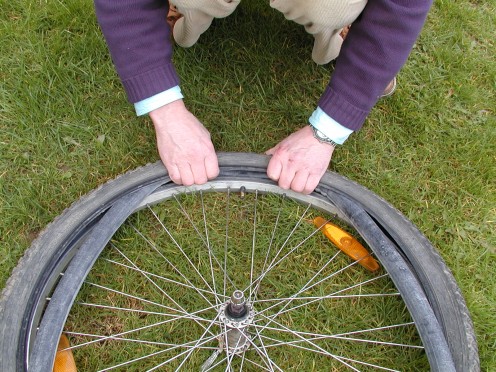 In this case, the help of a partner is required, who will press the wheel to the floor. After such an extreme straightening, the wheel is returned to the frame and tested.
In this case, the help of a partner is required, who will press the wheel to the floor. After such an extreme straightening, the wheel is returned to the frame and tested.
But this method is not always effective. It is not accurate, small deformations are not corrected. Among other things, inept actions can provoke new bends. And not every rim will succumb to the impact of the foot - high-strength modern wheels will remain “in their own way”. Although in case the wheel let you down somewhere along the way and the “eight” happened suddenly due to, for example, hitting a large stone, “power straightening” is the only possible way. nine0003
Wheel spoke adjustment
The ride quality of a bicycle often depends on the correct tension of the spokes. The tension of the spokes adds strength and elasticity to the wheel. The tires in this case are removed, the tension of each spoke is carefully checked. It happens that the rim is bent as a result of their general weakening. In a situation where the spokes dangle like guitar strings, they should be tightened by 1 turn of the key. In the found area of curvature, a spoke is searched for, located in its center, that is, at the very bulge. The rotation of the spoke must be carried out in the direction opposite to the direction of the bulge. In this case, the spokes located on the sides of the central one are weakened. nine0016
In a situation where the spokes dangle like guitar strings, they should be tightened by 1 turn of the key. In the found area of curvature, a spoke is searched for, located in its center, that is, at the very bulge. The rotation of the spoke must be carried out in the direction opposite to the direction of the bulge. In this case, the spokes located on the sides of the central one are weakened. nine0016
If the figure eight is between the two nearest knitting needles, then using a special key, the first knitting needle is tightened by a third of a turn, and the nearby knitting needle is twisted in the opposite direction, loosening the clamp also by a third. If the "eight" has a size of three knitting needles, the following actions are taken:
• tightening the central spoke by a quarter of a turn with a key;
• slight loosening of the outer spokes (two times less tension in the center). nine0003
If the "eight" has a size of seven knitting needles, the algorithm of actions is as follows:
• the central spoke is tightened by half a turn;
• the second and third spokes must be loosened by a quarter of a turn;
• the fourth and fifth are tightened by one eighth;
• the sixth and seventh (that is, extreme) are weakened by one eighth.
That is, the alternation of tension and stretching of the spokes should be carried out so that the extreme spokes of the “eight” are weakened. After the procedure, the wheel is installed in its place and tested for possible curvature. If the "eight" is curved in the opposite direction, all tension is eliminated and the tightening on the weakened knitting needles is increased. After that, everything repeats, but to a lesser extent. The result of a long operation is the alignment of the wheel to a perfectly even circle. At first, the work will not go so quickly, but with the acquisition of experience, the speed of adjusting the spokes also increases. nine0003
Change spokes
Not all craftsmen know how to assemble wheels with high quality, and therefore it is best to learn how to do it yourself. The assembly is carried out according to a certain algorithm.
1. Knitting work:
• it is necessary to lubricate the spoke threads and the rim in places where there is contact with the nipples, otherwise the spoke will not be tensioned with sufficient rigidity;
• in a situation where the sleeve flanges have a countersink on one side, the spoke heads are on the non-sinked side, it is needed to bend the spoke; nine0016 • nine spokes are inserted into the flange in such a way that there is an unoccupied hole between them, and that the heads are located on the outside. In a rear wheel situation, start on the right side of the hub;
In a rear wheel situation, start on the right side of the hub;
• on the rim, among the holes shifted to the right, one should find the one closest to the hole for the chamber nipple;
• the first spoke is attached in this hole, it is considered the key one;
• four holes should be counted from the key knitting needle, moving clockwise, put the next knitting needle and wrap the nipple; nine0016 • as a result, there should be three unoccupied holes between the spokes, the spoke closest to the valve hole is located to the right of it, and the cut part of the sleeve is facing the master;
• then the remaining seven spokes are fixed, using every fourth hole in the rim;
• after the wheel is turned over, nine more spokes are connected to the rim, which are inserted into the left flange from the outside;
• the tenth needle should be located to the right of the key one, adjacent to it, but not crossing; nine0016 • after mounting the tenth knitting needle, the next eight knitting needles are typed in the sequence defined above;
• and now the drive spokes are already in place and their heads are on the outside of the flange. In this case, the nipples are wrapped only by a certain number of revolutions;
In this case, the nipples are wrapped only by a certain number of revolutions;
• Tension spokes with heads are installed on the inner side of the flange. A spoke is threaded into the flange hole and the sleeve is rotated so that all the spokes that are in place receive a certain direction that is closest to the tangent relative to the flange. The first tension spoke must cross three drive spokes standing in place, while each tension should pass outside from the first two it crosses under the third, also intersected; nine0016 • other knitting needles get on the same principle.
2. Tension
Before tensioning the spokes, wrap all nipples equally. Then you need to start the process, wrapping each nipple one turn. If there is a “shiver” in the knitting needles, the tension increases. We install the wheel for verification and remove all defects such as the "eight".
Eliminate radial runout
The wheel rim in the form of an oval "egg" looks like this: one part of the rim is located closer to the center than the rest. Such a flaw in the wheel appears after unsuccessful landings. Fixing such a breakdown is much more difficult than the usual figure eight:
Such a flaw in the wheel appears after unsuccessful landings. Fixing such a breakdown is much more difficult than the usual figure eight:
1) remove the tire and inspect the rim;
2) turn the body of the bike over, spin the wheel while holding an object on top. Mark with chalk the part of the rim that will lift this object;
3) trace three directions at the same time:
- loosen the tension from the central spoke;
- pull the adjacent knitting needles by the same number of turns so that there is no figure eight;
- the spokes at the opposite end of the wheel should be tightened to prevent the appearance of an "egg" in another place. nine0003
Eliminating such a figure eight requires considerable experience, the process is characterized by its own difficulties. After correcting the “eggs”, you need to press on the knitting needles with all your weight, as in the above scheme - to shrink them.
Editing "Umbrella"
Cyclists are familiar with the concept of "umbrella". The defect is as follows: the wheel rim is shifted to one side and is not perfectly aligned with the center of the hub. How serious the situation from such a displacement directly to the bike depends on the design of the frame and on the configuration of the brakes. This type of malfunction often occurs when the wheel is assembled incorrectly. "Umbrella" is eliminated by analogy, like the usual eight. On the one hand, you need to tighten the knitting needles, and on the other, loosen. In contrast to the elimination of the usual figure eight, in the process of editing the umbrella, the force for each subsequent knitting needle should not be weaker, but should remain uniform along the entire circumference. nine0016
The defect is as follows: the wheel rim is shifted to one side and is not perfectly aligned with the center of the hub. How serious the situation from such a displacement directly to the bike depends on the design of the frame and on the configuration of the brakes. This type of malfunction often occurs when the wheel is assembled incorrectly. "Umbrella" is eliminated by analogy, like the usual eight. On the one hand, you need to tighten the knitting needles, and on the other, loosen. In contrast to the elimination of the usual figure eight, in the process of editing the umbrella, the force for each subsequent knitting needle should not be weaker, but should remain uniform along the entire circumference. nine0016
To summarize
Eights appear on the wheels of even the most experienced and savvy cyclists. In order to straighten the wheel, you need to remember a few simple rules. Always carefully tighten the spokes of the wheel - there is a risk of damage to the rim.